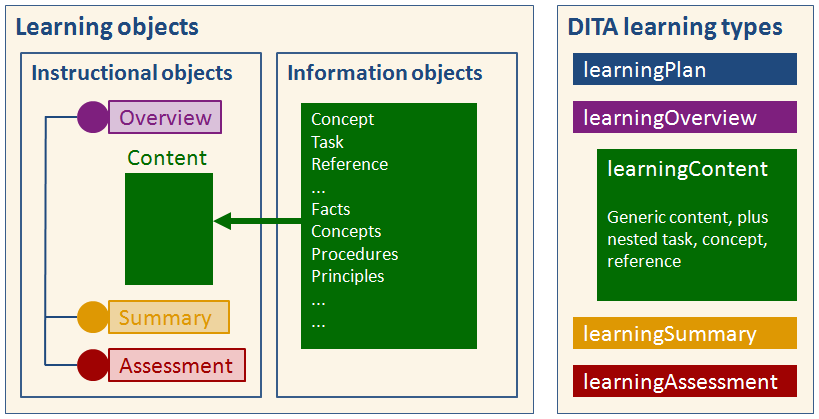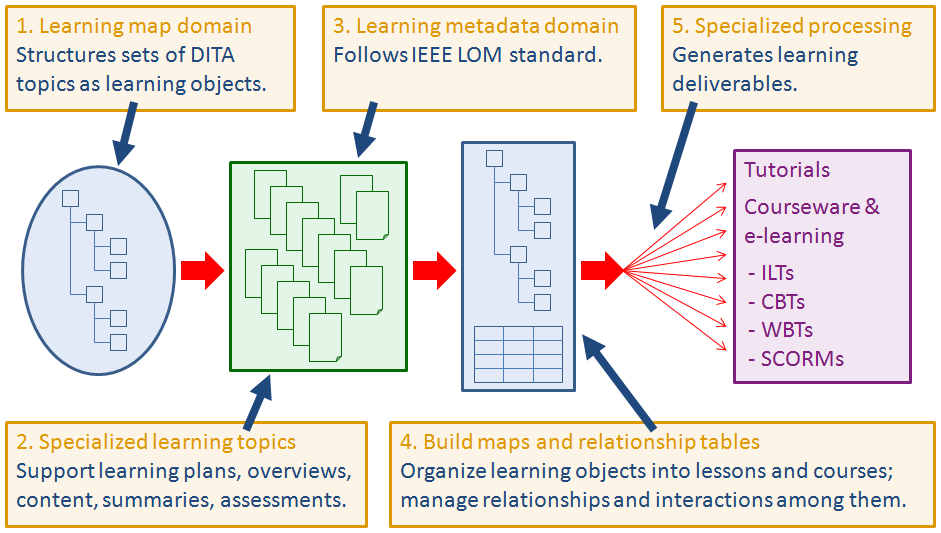A learning objects approach to learning and training content
The DITA learning and training specializations apply DITA principles and best practices for using topic-based and modular content to plan, develop, and deliver learning and training content.
The reusable learning objects, or RLO, approach to learning content derives from the pioneering work of learning content designers at several companies, including Autodesk®, Oracle®, and Cisco®. Author Peder Jacobsen defines an RLO as "a discrete reusable collection of content used to present and support a single learning objective." With this approach, it is possible to gather a pool of information objects and make them available for reuse and repurposing in a variety of learning delivery contexts.
There is a strong affinity between the DITA topic-based, modular approach to content in general, and the learning objects approach to learning content in particular.
- The DITA Learning and Training specialization builds on a reusable learning objects (RLO) approach to learning content.
- DITA topic types are the basic building blocks for learning objects and specify the meaning and intention of content provided in instructional and information objects.
- DITA domains provide the mechanism for defining interactions, which can be used across the learning topic types.
- DITA domains also provide the mechanism for defining learning metadata, which can be assigned either in topics or in maps.
- DITA maps arrange the DITA learning topics into a hierarchy of learning objects and group such content for delivery as lessons, modules, and courses.
- DITA specialization provides the mechanism for creating the learning-based topic types, domains, and maps needed for instructional and information object content requirements.
This figure shows the composition of learning objects as a) instructional objects, b) information objects, and c) the specialized DITA topic types to support them.

- instructional
objects, which provide the structured framework for a learning experience.
The
<learningOverview>,<learningSummary>, and<learningAssessment>topic types provide content for instructional objects. - information
objects, which provide the source learning content - the topic-based
learning content and other supplemental content that supports the learning
goals identified in the instructional objects. The
<learningContent>topic type provides content for information objects. - instructional
plans, which identify the learning goals, needs, and objectives. The
<learningPlan>topic type provides content for instructional plans.

- Uses learning map elements to identify the learning objects and the supporting content needed to address specific learning goals and objectives.
- Uses learning topic elements to structure the learning content.
- Applies learning metadata elements to describe specific characteristics of the learning content, following a sub-set of the IEEE LOM standard.
- Constructs specific build maps and relationship tables to organize learning objects for delivery as a course with specific output and delivery needs.
- Invokes processing to generate specific learning deliverables, based on the default processing available with DITA content and specialized as needed for learning-specific purposes and delivery formats.